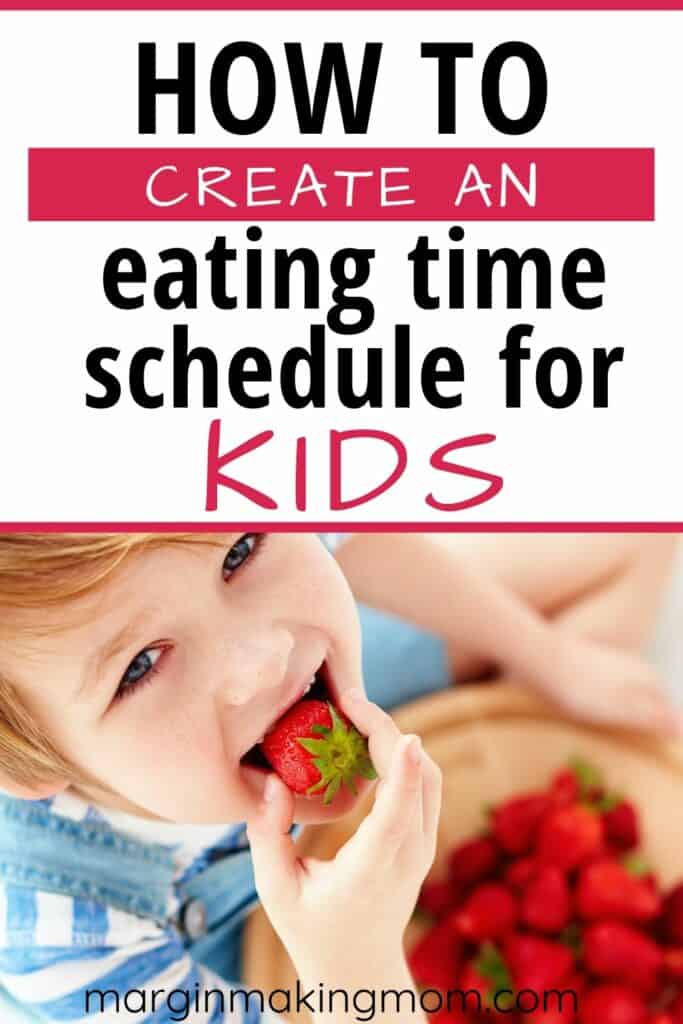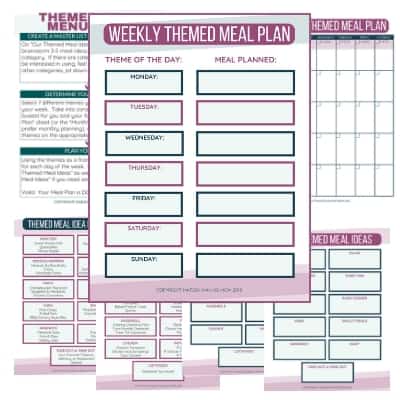Creating a good eating schedule for your kids provides predictability and promotes healthy habits.

Setting up an eating time schedule for your child or toddler helps to provide some structure around food–saving your sanity and giving your child the security of a routine!
Note: This post may contain affiliate links for your convenience. If you make a purchase, this site may receive a small commission at no additional cost to you. You can read my full disclosure policy here.
Kids and their appetites can be so unpredictable at times, can’t they? One moment, they are refusing the meal we prepared, and the next minute, they’re suddenly a bottomless pit!
It can seem like the requests for snacks are endless at times, leaving you exhausted and frustrated.
Not only that, but when kids eat all day, they often aren’t very hungry at mealtimes, so they aren’t as likely to try new foods.
Having a set schedule for eating can really help to alleviate some of the stress, and can also be helpful with picky eaters!
Related Resources for Picky Eaters:
- Best Kids’ Books for Picky Eaters
- Easy Dinners for Picky Eaters
- Healthy Meals for Picky Eaters
- Lunch Ideas for Picky Eaters

Why an Eating Schedule is Healthy for Everyone
If you are able to set up some structure surrounding feeding times for your family, it can have a lot of really practical benefits.
The Kitchen is Closed
First of all, it eliminates the need for you to constantly be in the kitchen, dishing out food to all of your little people.
If you have just one kid, it might not be as big of a deal, but when you have more than one, you could easily spend ALL DAY LONG trying to meet everyone’s individual preferences.
Structure is Security
Second, it gives your kids some predictability to rely on and can help mitigate behavioral issues. Kids thrive in the security of routine.
If they know that snack time is coming up soon, they’ll be less likely to beg for a snack right this minute.
After age one or two, most kids can tolerate a degree of hunger (this does not refer to infants or very young toddlers, who should generally be fed on demand).
Erratic mealtimes and snacktimes can lead to overeating and inability to regulate an appetite.
So having a predictable flow prevents everyone from “grazing” all day, and allows everyone to come to the table at mealtimes ready to eat, but not famished.
How to Set a Schedule for Meals and Snacks
It’s important to note that the schedule that works for one family may not work for another family.
I am personally a fan of creating more of a “routine” surrounding food, instead of a set-in-stone schedule with specific times.
For instance, in my own family, with children ages 7, 5, and 4, everyone typically eats breakfast around 7:15am.
Then, we don’t eat again until our morning snack time, around 9:45-10:00. This is a light snack.
We have lunch around 12:00-12:30pm, then we have an afternoon snack once naps are finished, around 3:00pm.
Dinner is usually around 5:30-6:00pm. So on average, we are allowing 1-2 hours of no eating before and after a meal.
Different times may work better for your family, but think about a way that you can create some structure around eating times.
This is just a normal, predictable part of our daily routine.

How to Involve Children in a Mealtime Routine
There are many ways you can involve your child in the mealtime schedule, so it doesn’t seem so “dictatorial.”
You can allow children to help with planning the meals and snacks, setting the table, gathering ingredients or materials needed, and assisting with preparation in an age-appropriate way.
This allows them to learn important skills as well as feel a sense of belonging and importance.
What if the Eating Schedule Needs to Change?
If you are departing from your normal routine for the day, let kids know ahead of time if possible.
If you’re going to be out at a restaurant, try to set your child up for success by bringing along a small toy or snack to help them while they wait.
As your children grow, your regular schedule may need to change. For instance, very young children often need more frequent small snacks than older children do.
Don’t become a slave to the schedule–allow it to morph with your family’s needs over time!
Providing an Eating Time Schedule for Your Kids
The most important thing is that you create some predictability and security for your kids through a routine, while also eliminating the need to feed everyone on demand all of the time!
Take some time to consider your family’s needs and try out the idea of having a mealtime routine!










Leave a Reply